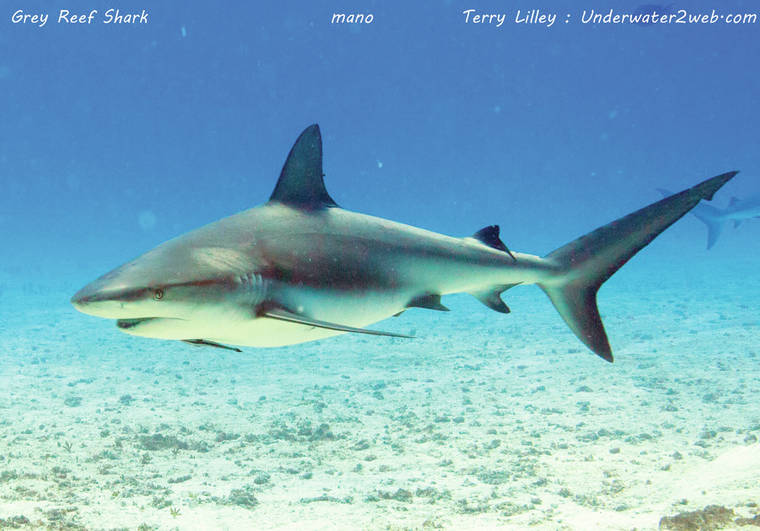This eight--foot-long, 300-pound shark is quite rare in the main Hawaiian Islands, but there are a pair of them that live in Hanalei Bay. They are more common around the islands of Ni‘ihau and Molokini, and they tend to be territorial.
This eight–foot-long, 300-pound shark is quite rare in the main Hawaiian Islands, but there are a pair of them that live in Hanalei Bay. They are more common around the islands of Ni‘ihau and Molokini, and they tend to be territorial.
The gray reef shark is actually quite shy, and as a diver I rarely see them except from time to time while I am spearfishing. I was spearing the invasive roi (peacock grouper) in Hanalei Bay one summer day about 50 yards offshore and had one of the gray reef sharks following me all the way back to shore trying to steal the roi off of my spear gun. As a general rule these sharks will not bother swimmers, surfers or divers, and in Tahiti and Palau we sometimes dive with schools of over 20 gray reef sharks and are quite relaxed.
In Hawai‘i most divers see the white-tipped reef sharks laying on the sea floor sleeping during the day. White tips can breathe through their gills when laying still on the sea floor, but the gray reef sharks need to be constantly swimming to push water through their gills, so they have to keep moving their entire lives.
These sharks feed on sick and injured fish, and rarely even attempt to chase and catch a healthy fish. I have seen huge schools of jacks just relaxing only 10 feet away from a large hungry gray reef shark, but if someone spears the jack or catches it on a fishing line the gray reef shark will zoom in at a lightening speed and grab the wounded fish. This type of feeding behavior keeps the fish populations healthy and strong by making sure there are no unhealthy fish to spread disease or breed.
The only time I have seen one of these sharks become agitated with a diver was at Ni‘ihau when we came across a pregnant female. You can tell easily when a shark becomes aggressive because they arch their back upwards, lower their pectoral fins and make fast, jerky movements. The pregnant female became very nervous and went into an aggressive posture, so we decided it was time to find another part of the reef to dive on.
You can learn all about aggressive shark behavior and watch the current TV segment I am in on the National Geographic Go Wild Sharkfest TV show airing this summer. I talk about the increasing amount of large shark versus human altercations happening in Maui and why these may be happening.
You can also see mano in action in the documentary movie, “The World’s Guide to Hawaiian Reef Fish” on the underwater educational web page at underwater2web.com, and also follow my ongoing shark post on my Instagram at terry.lilley
Aloha from under the surf.
•••
Terry Lilley, a marine biologist, lives in Hanalei. His websites include underwater-2web.com and www.gofundme.com/5urrm4zw.





Informative and a fun read. Thank you, Terry.
Cool article as usual Terry! Keep them coming!
Mahalo